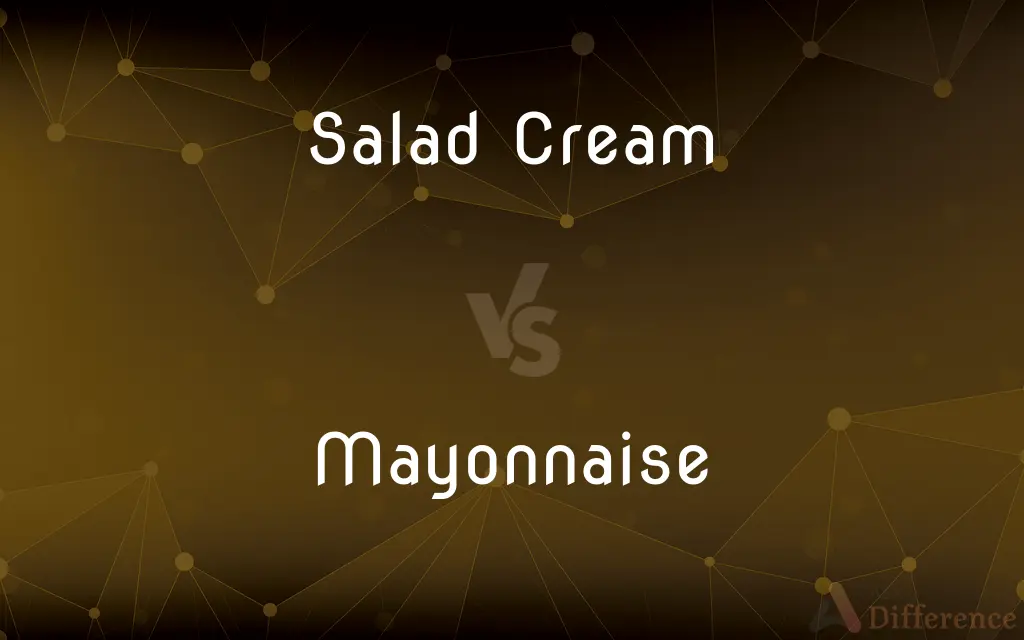Salad Cream vs. Mayonnaise — What's the Difference?
By Tayyaba Rehman — Published on October 27, 2023
Salad Cream is a tangy, thinner condiment often used on salads, while Mayonnaise is a thicker, creamy emulsion typically made from oil, egg yolk, and vinegar or lemon juice.

Difference Between Salad Cream and Mayonnaise
Table of Contents
ADVERTISEMENT
Key Differences
Salad Cream and Mayonnaise, while often confused, are distinct condiments with unique tastes and applications. Salad Cream is characterized by its tangy flavor and runnier consistency. It often incorporates ingredients such as mustard, vinegar, and a smaller amount of oil than Mayonnaise. On the other hand, Mayonnaise boasts a creamy texture derived mainly from its blend of oil, egg yolk, and an acid, usually vinegar or lemon juice.
Both Salad Cream and Mayonnaise can elevate the taste of various dishes. However, Salad Cream is traditionally used as a dressing for salads, offering a piquant kick. Mayonnaise, being neutral and creamy, is versatile, finding its way into sandwiches, dips, and numerous recipes as a base or ingredient.
Compositionally, there's a marked difference between the two. Salad Cream contains more water, vinegar, and additional flavorings, resulting in its signature tang and thinner consistency. Mayonnaise, with its higher oil content, takes on a denser, more velvety texture, providing a smooth palate experience.
Although regions like the UK relish the unique taste of Salad Cream, Mayonnaise enjoys a more global recognition and application. In culinary practices, while Salad Cream might be preferred for certain traditional dishes, Mayonnaise's versatility makes it a staple in kitchens worldwide.
Comparison Chart
Primary Ingredients
Mustard, vinegar, less oil
Oil, egg yolk, vinegar or lemon juice
ADVERTISEMENT
Consistency
Thinner
Thicker, creamy
Flavor
Tangy
Neutral to mild
Traditional Use
Dressing for salads
Sandwich spread, base for dips and sauces
Global Popularity
More popular in specific regions like the UK
Widely recognized and used globally
Compare with Definitions
Salad Cream
Features a runnier consistency than Mayonnaise.
Because of its flowy texture, Salad Cream easily coated the vegetables.
Mayonnaise
A thick, creamy condiment made from oil, egg yolk, and acid.
He slathered Mayonnaise on his sandwich for extra richness.
Salad Cream
A tangy condiment primarily used on salads.
She drizzled some Salad Cream over her garden salad for added zest.
Mayonnaise
Widely used in various cuisines and dishes.
The recipe called for two tablespoons of Mayonnaise for creaminess.
Salad Cream
Often chosen for its sharp, piquant flavor.
For those preferring a tangy kick, Salad Cream was the preferred choice.
Mayonnaise
Can serve as a base for various sauces and dips.
She mixed chili sauce with Mayonnaise to create a spicy dip.
Salad Cream
Less oily compared to Mayonnaise.
She opted for Salad Cream, wanting a lighter, less oily dressing.
Mayonnaise
Has a neutral flavor profile, complementing diverse ingredients.
Mayonnaise in the tuna salad allowed the flavors of the fish and celery to shine.
Salad Cream
Contains ingredients like mustard and vinegar.
The hint of mustard in the Salad Cream gave it a distinct taste.
Mayonnaise
A thick dressing made of beaten raw egg yolk, oil, lemon juice or vinegar, and seasonings.
Mayonnaise
A dressing made from vegetable oil, raw egg yolks, vinegar or lemon juice, and seasoning, used on salads, with french fries, in sandwiches etc.
Mayonnaise
Any cold dish with that dressing as an ingredient.
We served a lobster mayonnaise as a starter.
Hair mayonnaise
Facial mayonnaise
Mayonnaise
(transitive) To cover or season with mayonnaise.
Mayonnaise
A thick white sauce compounded of raw yolks of eggs beaten up with olive oil to the consistency near to that of a gel, and seasoned with vinegar, pepper, salt, etc.; - used in dressing salads, fish, etc. Also, a dish dressed with this sauce.
Mayonnaise
Egg yolks and oil and vinegar
Mayonnaise
Primarily composed of oil, making it dense and creamy.
The Mayonnaise added a velvety texture to the potato salad.
Common Curiosities
How does Mayonnaise differ from Salad Cream in flavor?
Mayonnaise has a neutral to mild flavor, while Salad Cream is distinctly tangy.
Is Salad Cream popular worldwide?
Salad Cream has regional popularity, like in the UK, while Mayonnaise is globally recognized.
Is Mayonnaise used only as a spread?
No, Mayonnaise is versatile and can be used in recipes, as a base for sauces, and more.
What is Salad Cream?
Salad Cream is a tangy condiment, often thinner than Mayonnaise, primarily used for salads.
Can Salad Cream be used as a substitute for Mayonnaise?
While possible, the result will be tangier and less creamy than if using Mayonnaise.
Why is Mayonnaise creamier?
The high oil content in Mayonnaise gives it a creamier texture compared to Salad Cream.
Can I make Salad Cream at home?
Yes, using ingredients like mustard, vinegar, and a bit of oil, you can prepare homemade Salad Cream.
Why does Salad Cream have a tangy taste?
The presence of ingredients like vinegar and mustard gives Salad Cream its tangy flavor.
What are the main ingredients in Mayonnaise?
Mayonnaise's primary ingredients are oil, egg yolk, and vinegar or lemon juice.
Share Your Discovery

Previous Comparison
Retail Banking vs. Universal Banking
Next Comparison
Fiscal Policy vs. Monetary PolicyAuthor Spotlight
Written by
Tayyaba RehmanTayyaba Rehman is a distinguished writer, currently serving as a primary contributor to askdifference.com. As a researcher in semantics and etymology, Tayyaba's passion for the complexity of languages and their distinctions has found a perfect home on the platform. Tayyaba delves into the intricacies of language, distinguishing between commonly confused words and phrases, thereby providing clarity for readers worldwide.













































